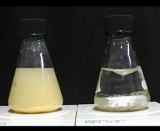
TEL. +81-6-6879-7437
Yamadaoka 2-1, Suita, Osaka 565-0871 Japan
RESEARCH
In vitro Metabolic Engineering

Bioproduction of value-added chemicals has been widely recognized as a
key technology to promote the sustainability of chemical industries. Our
group has developed a novel technology to engineer an artificial metabolic
pathway specialized for chemical manufacturing by assembling multiple enzymes
in vitro. Enzymes from thermophilic microorganisms are heterologously expressed
in mesophilic hosts (e.g., Escherichia coli) and used as catalytic modules for pathway construction. This approach
is, in principle, available for all thermophilic enzymes as long as they
can be functionally expressed in mesophilic hosts, allowing us to design
a bespoke metabolic pathway in vitro. We referred to this technology as
“in vitro metabolic engineering” and construct a variety of artificial
pathways for the on-demand production of useful chemicals.
Non-aqueous Bioprocess
The use of organic solvents as reaction media has the potential to greatly
expand the repertoire of bioproduction. Successful examples of bioproduction
in nonaqueous media using enzymes including lyophilized lipases, esterases,
and proteases have been reported. However, most of these biocatalytic convesions
involve relatively simple, single-step hydrolytic enzymes. One of the challenges
in this area is the utilization of more complex enzymatic reactions involving
multicomponent enzymes, cofactor regeneration, and multistep enzymatic
conversions in organic solvent. Theerfore, attention has been paid to the
development of a whole-cell catalyst that functions in nonaqueous environment.
Rhodococcus opacus B-4 cells exhibit a high affinity for water-immiscible hydrocarbons and
dispersible in essentially water-free organic solvents. Owing to these
hydrophobic features, R. opacus B-4 can easily access to the water-insoluble chemicals dissolved in organic
solvnets and have an advantage in taking up them. By using R.opacus B-4 cells as "hydrophobic biocatalytic particles", we are developing
nonaquesous bioprocesses for the production of water-insoluble chemicals.
 Behavior of Rhodococcus opacus and Escherichia coli in a water-immiscible organic solvent.
Behavior of Rhodococcus opacus and Escherichia coli in a water-immiscible organic solvent.
The wet cells of R. oapcus (left) and E. coli (right) were put in an Erlenmeyer flask containing cyclohexane and mixed
with a magnetic stirrer. Although E. coli cells are repelled from the solvent, R. opacus cells can be suspended in cyclohexane.
バナースペース
SYNTHETIC BIOENGINEERING LAB
Dept.of Biotechnology
Graduate School of Engineering,
Osaka University
Yamadaoka 2-1, Suita Osaka
565-0871 Japan
Phone:+81-6-6879-7437
Fax :+81-6-6879-7439